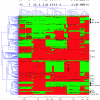Determination of the relationship between group A streptococcal genome content, M type, and toxic shock syndrome by a mixed genome microarray
- PMID: 17325055
- PMCID: PMC1865738
- DOI: 10.1128/IAI.01291-06
Determination of the relationship between group A streptococcal genome content, M type, and toxic shock syndrome by a mixed genome microarray
Abstract
Group A streptococci (GAS), or Streptococcus pyogenes, are associated with a remarkable variety of diseases, ranging from superficial infections to life-threatening diseases such as toxic-shock-like syndrome (TSS). GAS strains belonging to M types M1 and M3 are associated with TSS. This study aims to obtain insight into the gene profiles underlying different M types and disease manifestations. Genomic differences between 76 clinically well characterized GAS strains collected in The Netherlands were examined using a mixed-genome microarray. Inter-M-type genomic differences clearly outweighed intra-M-type genome variation. Phages were major contributors to observed genome diversification. We identified four novel genes, including two genes encoding fibronectin-binding-like proteins, which are highly specific to a subset of M types and thus may contribute to M-type-associated disease manifestations. All M12 strains were characterized by the unique absence of the citrate lyase complex and reduced growth under hypoxic, nutrient-deprived conditions. Furthermore, six virulence factors, including genes encoding a complement-inhibiting protein (sic), an exotoxin (speA), iron(III) binding factor, collagen binding factor (cpa), and fibrinogen binding factor (prt2-like), were unique to M1 and/or M3 strains. These virulence factors may contribute to the potential of these strains to cause TSS. Finally, in contrast to M-type-specific virulence profiles, we did not identify a common virulence profile among strains associated with TSS irrespective of their M type.
Figures


Similar articles
-
Dynamics in prophage content of invasive and noninvasive M1 and M28 Streptococcus pyogenes isolates in The Netherlands from 1959 to 1996.Infect Immun. 2007 Jul;75(7):3673-9. doi: 10.1128/IAI.01695-06. Epub 2007 Apr 23. Infect Immun. 2007. PMID: 17452467 Free PMC article.
-
Comparative analysis of emm type pattern of Group A Streptococcus throat and skin isolates from India and their association with closely related SIC, a streptococcal virulence factor.BMC Microbiol. 2008 Sep 16;8:150. doi: 10.1186/1471-2180-8-150. BMC Microbiol. 2008. PMID: 18796133 Free PMC article.
-
Description of the Pathogenic Features of Streptococcus pyogenes Isolates from Invasive and Non-Invasive Diseases in Aichi, Japan.Jpn J Infect Dis. 2016 Jul 22;69(4):338-41. doi: 10.7883/yoken.JJID.2015.334. Epub 2015 Nov 13. Jpn J Infect Dis. 2016. PMID: 26567838
-
Variation, Indispensability, and Masking in the M protein.Trends Microbiol. 2018 Feb;26(2):132-144. doi: 10.1016/j.tim.2017.08.002. Epub 2017 Aug 31. Trends Microbiol. 2018. PMID: 28867148 Free PMC article. Review.
-
[Genetic analysis and virulence factors of group A streptococci that cause severe invasive infectious diseases].Tanpakushitsu Kakusan Koso. 2005 Mar;50(3):253-61. Tanpakushitsu Kakusan Koso. 2005. PMID: 15773306 Review. Japanese. No abstract available.
Cited by
-
Comparative genome analysis of a large Dutch Legionella pneumophila strain collection identifies five markers highly correlated with clinical strains.BMC Genomics. 2010 Jul 15;11:433. doi: 10.1186/1471-2164-11-433. BMC Genomics. 2010. PMID: 20630115 Free PMC article.
-
Invasion of endothelial cells by tissue-invasive M3 type group A streptococci requires Src kinase and activation of Rac1 by a phosphatidylinositol 3-kinase-independent mechanism.J Biol Chem. 2009 Jul 24;284(30):20319-28. doi: 10.1074/jbc.M109.016501. Epub 2009 May 27. J Biol Chem. 2009. PMID: 19473989 Free PMC article.
-
Molecular characteristics of pharyngeal and invasive emm3 Streptococcus pyogenes strains from Norway, 1988-2003.Eur J Clin Microbiol Infect Dis. 2010 Jan;29(1):31-43. doi: 10.1007/s10096-009-0814-5. Epub 2009 Oct 6. Eur J Clin Microbiol Infect Dis. 2010. PMID: 19806374
-
The burden of group A Streptococcus (GAS) infections: The challenge continues in the twenty-first century.iScience. 2024 Dec 24;28(1):111677. doi: 10.1016/j.isci.2024.111677. eCollection 2025 Jan 17. iScience. 2024. PMID: 39877071 Free PMC article. Review.
-
Optimizing Antibiotic Choice, Administration, and Duration in NSTI Treatment.Bioengineering (Basel). 2025 Jun 24;12(7):691. doi: 10.3390/bioengineering12070691. Bioengineering (Basel). 2025. PMID: 40722383 Free PMC article. Review.
References
-
- Abe, J., J. Forrester, T. Nakahara, J. A. Lafferty, B. L. Kotzin, and D. Y. Leung. 1991. Selective stimulation of human T cells with streptococcal erythrogenic toxins A and B. J. Immunol. 146:3747-3750. - PubMed
-
- Akesson, P., A. G. Sjoholm, and L. Bjorck. 1996. Protein SIC, a novel extracellular protein of Streptococcus pyogenes interfering with complement function. J. Biol. Chem. 271:1081-1088. - PubMed
-
- Banks, D. J., S. B. Beres, and J. M. Musser. 2002. The fundamental contribution of phages to GAS evolution, genome diversification and strain emergence. Trends Microbiol. 10:515-521. - PubMed
-
- Banks, D. J., S. F. Porcella, K. D. Barbian, S. B. Beres, L. E. Philips, J. M. Voyich, F. R. DeLeo, J. M. Martin, G. A. Somerville, and J. M. Musser. 2004. Progress toward characterization of the group A Streptococcus metagenome: complete genome sequence of a macrolide-resistant serotype M6 strain. J. Infect. Dis. 190:727-738. - PubMed
MeSH terms
Substances
LinkOut - more resources
Full Text Sources
Other Literature Sources

